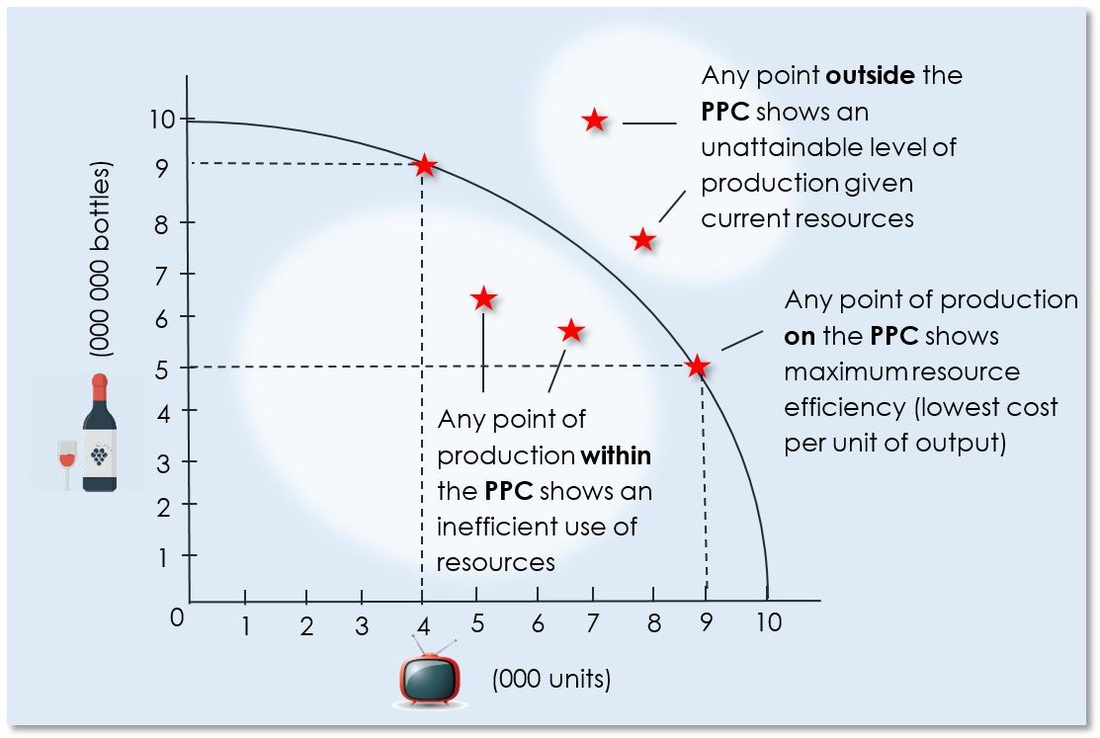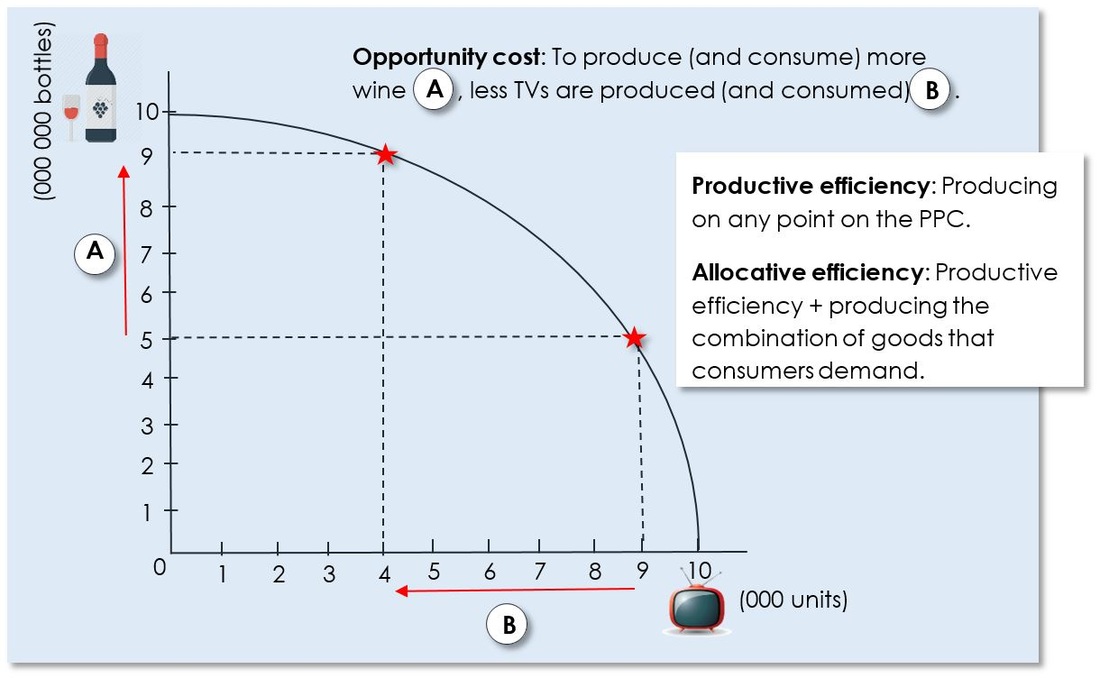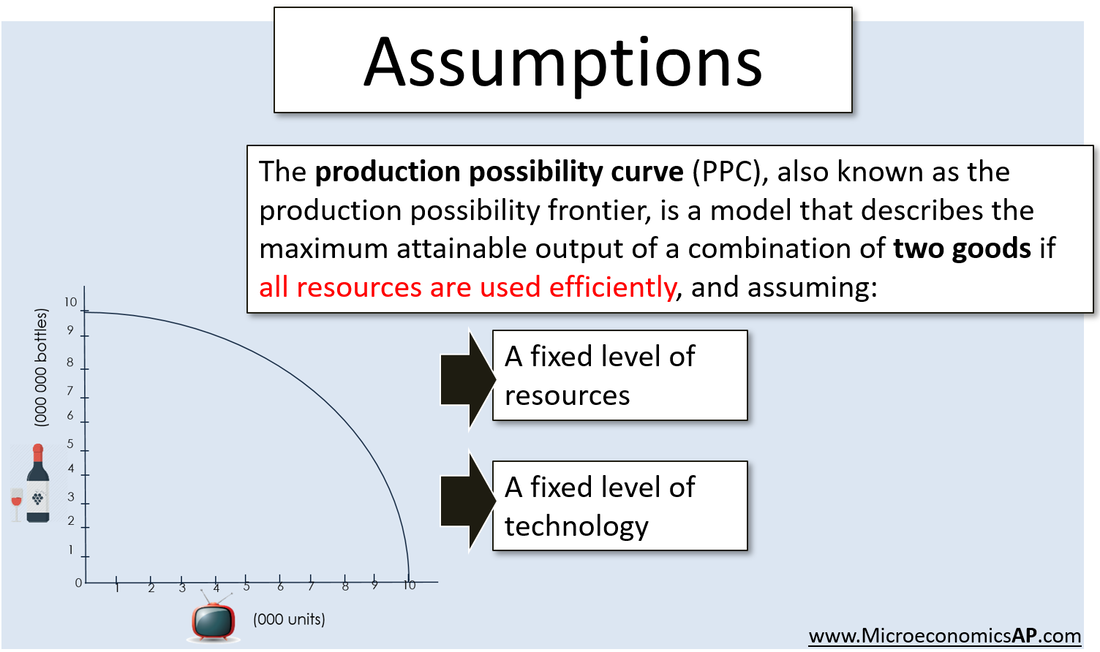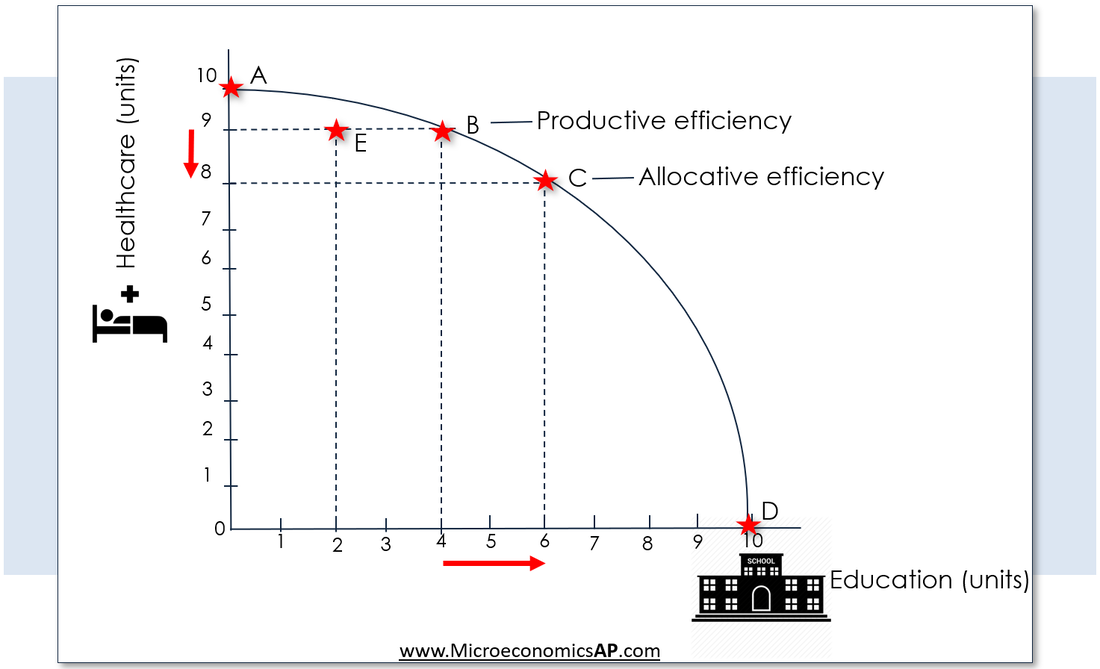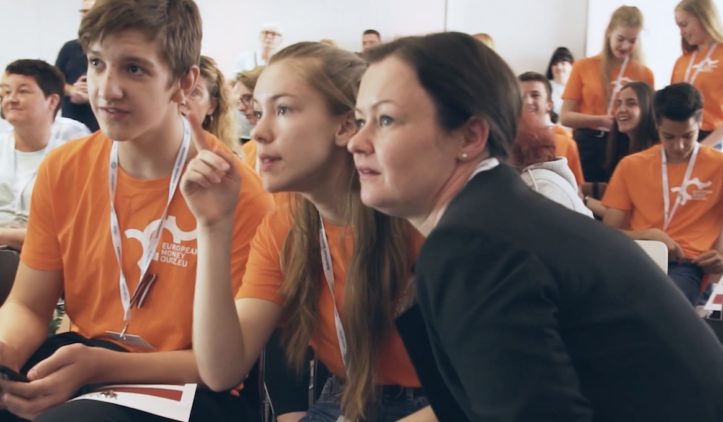AP® MICROECONOMICS:
|
|
Production Possibility frontiers – Topics:
|
Production Possibility FrontiersLearning objectives
|
Production Possibility FrontierProduction possibility curves are critical to understanding both absolute and comparative advantage in AP Microeconomics. The production possibility curve (PPC) is a curve depicting all maximum output possibilities for two goods, given a set of inputs consisting of resources and other factors. The PPC assumes that all inputs are used efficiently.
Explaining the PPC
|
The PPF in International TradeThe PPC shows the maximum number of goods that can be produced if an economy is using all of its resources (factors of production) efficiently. This will result in the lowest average unit costs, and the lowest price in a perfectly competitive market.
Only two goods. The Production Possibility Curve model that is used in AP Microeconomics to explain absolute and comparative advantage assumes that only two goods or services are being produced or consumed.
|
Assumptions of THE PPF/PPC modelThe four key assumptions underlying production possibilities analysis are:
|
SUnk costsA sunk cost is a cost that has already been incurred and cannot be recovered. A sunk cost differs from future costs that a business may face, such as decisions about inventory purchase costs or product pricing. Sunk costs (past costs) are excluded from future business decisions because the cost will be the same regardless of the outcome of a decision.
|
Social choices and the PPFA Healthcare vs. Education Production Possibilities Frontier This production possibilities frontier shows a tradeoff between devoting social resources to healthcare and devoting them to education. At A all resources go to healthcare and at B, most go to healthcare. At D most resources go to education, and at F, all go to education.
Just as individuals cannot have everything they want and must instead make choices, society as a whole cannot have everything it might want, either. The constraints faced by society can be explored using a model called the production possibilities frontier (PPF).
There are more similarities than differences between individual choice and social choice. As you go through this topic, focus on the similarities. Because society has limited resources (e.g., labor, land, capital, raw materials) at any point in time, there is a limit to the quantities of goods and services it can produce. Suppose a society desires two products, healthcare and education. |
This situation is illustrated by the production possibilities frontier in, left. In this figure, healthcare is shown on the vertical axis and education is shown on the horizontal axis. If the society were to allocate all of its resources to healthcare, it could produce at point A. But it would not have any resources to produce education. If it were to allocate all of its resources to education, it could produce at point F. Alternatively, the society could choose to produce any combination of healthcare and education shown on the production possibilities frontier. In effect, the production possibilities frontier plays the same role for society as the budget constraint plays for Annabel. Society can choose any combination of the two goods on or inside the PPF. But it does not have enough resources to produce outside the PPF. Most important, the production possibilities frontier clearly shows the tradeoff between healthcare and education.
Suppose society has chosen to operate at Point C, and it is considering producing more Healthcare at Point B. Because the PPF is downward sloping from left to right, the only way society can obtain more healthcare is by giving up some healthcare. That is the trade off society faces. Suppose it considers moving from Point C to Point B. What would the opportunity cost be for the additional healthcare? The opportunity cost would be the healthcare society has to give up. We can see that to produce an additional 4 units of healthcare (the red arrow on the healthcare axis), 5 units of education are foregone (the red arrow on the education axis). |
The shape of the PPFThe budget constraints presented earlier in this chapter, showing individual choices about what quantities of goods to consume, were all straight lines. The reason for these straight lines was that the slope of the budget constraint was determined by relative prices of the two goods in the consumption budget constraint. However, the production possibilities frontier for healthcare and education was drawn as a curved line. Why does the PPF have a different
shape? To understand why the PPF is curved, start by considering Point A at the top left-hand side of the PPF. At Point A, all available resources are devoted to healthcare and none are left for education. This situation would be extreme and even ridiculous. For example, children are seeing a doctor every day, whether they are sick or not, but not attending school. People are having cosmetic surgery on every part of their bodies, but no high school or college education exists. Now imagine that some of these resources are diverted from healthcare to education, so that the economy is at Point B instead of Point A. Diverting some resources away from A to B causes relatively little reduction in health because the last few marginal dollars going into healthcare services are not producing much additional gain in health. However, putting those marginal dollars into education, which is completely without resources at Point A, can produce relatively large gains. For this reason, the shape of the PPF from A to B is relatively flat, representing a relatively small drop-off in health and a relatively large gain in education. Now consider the other end, at the lower right, of the production possibilities frontier. Imagine that society starts at Point C, which is devoting nearly all resources to education and very few to healthcare, and moves to Point D, which is devoting all spending to education and none to healthcare. For the sake of concreteness, you can imagine that in the movement from Point C to Point D, the last few doctors must become high school science teachers, the last few nurses must become school librarians rather than dispensers of vaccinations, and the last few emergency rooms are turned into kindergartens. The gains to education from adding these last few resources to education are very small. |
Diminishing marginal returnsHowever, the opportunity cost lost to health will be fairly large, and thus the slope of the PPF between Point C and Point D is steep, showing a large drop in health for only a small gain in education.
The lesson is not that society is likely to make an extreme choice like devoting no resources to education at Point A or no resources to health at Point D. Instead, the lesson is that the gains from committing additional marginal resources to education depend on how much is already being spent. If on the one hand, very few resources are currently committed to education, then an increase in resources used can bring relatively large gains. On the other hand, if a large number of resources are already committed to education, then committing additional resources will bring relatively smaller gains. This pattern is common enough that it has been given a name: the law of diminishing returns, which holds that as additional increments of resources are added to a certain purpose, the marginal benefit from those additional increments will decline. When government spends a certain amount more on reducing crime, for example, the original gains in reducing crime could be relatively large. But additional increases typically cause relatively smaller reductions in crime, and paying for enough police and security to reduce crime to nothing at all would be tremendously expensive. The curvature of the production possibilities frontier shows that as additional resources are added to education, moving from left to right along the horizontal axis, the original gains are fairly large, but gradually diminish. Similarly, as additional resources are added to healthcare, moving from bottom to top on the vertical axis, the original gains are fairly large, but again gradually diminish. In this way, the law of diminishing returns produces the outward bending shape of the production possibilities frontier. |
Productive and allocative EFFICIENCYThe study of economics does not presume to tell a society what choice it should make along its production possibilities frontier. In a market-oriented economy with a democratic government, the choice will involve a mixture of decisions by individuals, firms, and government. However, economics can point out that some choices are unambiguously better than others. This observation is based on the concept of efficiency. In everyday usage, efficiency refers to lack of waste. An inefficient machine operates at high cost, while an efficient machine operates at lower cost, because it is not wasting energy or materials. An inefficient organization operates with long delays and high costs, while an efficient organization meets schedules, is focused, and performs within budget.
The production possibilities frontier can illustrate two kinds of efficiency: productive efficiency and allocative efficiency. The figure right illustrates these ideas using a production possibilities frontier between healthcare and education. Productive efficiency means that, given the available inputs and technology, it is impossible to produce more of one good without decreasing the quantity that is produced of another good. All choices on the PPF (above right), including Points A, B, C, and D, display productive efficiency. As a firm moves from any one of these choices to any other, either healthcare increases and education decreases or vice versa. However, any choice inside the production possibilities frontier is productively inefficient and wasteful because it is possible to produce more of one good, the other good, or some combination of both goods.
For example, Point E is productively inefficient because it is possible at choice E to have more of both goods: education on the horizontal axis is higher at Point B than Point E. The particular mix of goods and services being produced—that is, the specific combination of healthcare and education chosen along the production possibilities frontier—can be shown as a ray (line) from the origin to a specific point on the PPF. Output mixes that had more healthcare (and less education) would have a steeper ray, while those with more education (and less healthcare) would have a flatter ray. Allocative efficiency means that the particular mix of goods a society produces represents the combination that society most desires. How to determine what a society desires can be a controversial question, and is usually discussed in political science, sociology, and philosophy classes as well as in economics. At its most basic, allocative efficiency means producers supply the quantity of each product that consumers demand. Only one of the productively efficient choices will be the allocatively efficient choice for society as a whole. |
Productive efficiency means it is impossible to produce more of one good without decreasing the quantity that is produced of another good. Thus, all choices along a given PPF like Points A, B, C and D display productive efficiency, but A does not.
Allocative efficiency means that the particular mix of goods being produced—that is, the specific choice along the production possibilities frontier—represents the allocation that society most desires. The society in the above PPF desires relatively more education and is willing to forgo some healthcare to achieve this (Point C, rather than Point B). Productive efficiency explainedWhy society must chooseEvery economy faces two situations in which it may be able to expand consumption of all goods. In the first case, a society may discover that it has been using its resources inefficiently, in which case by improving efficiency and producing on the production possibilities frontier, it can have more of all goods (or at least more of some and less of none). In the second case, as resources grow over a period of years (e.g., more labor and more capital), the economy grows. As it does, the production possibilities frontier for a society will tend to shift outward and society will be able to afford more of all goods.
But improvements in productive efficiency take time to discover and implement, and economic growth happens only gradually. So, a society must choose between tradeoffs in the present. For government, this process often involves trying to identify where additional spending could do the most good and where reductions in spending would do the least harm. At the individual and firm level, the market economy coordinates a process in which firms seek to produce goods and services in the quantity, quality, and price that people want. But for both the government and the market economy in the short term, increases in production of one good typically mean offsetting decreases somewhere else in the economy. |
AP® MICROECONOMICS – POWERPOINT SUMMARY NOTES:
1.4 The Production POSSIBILITY Frontier
PROGRESS CHECK - TEST YOUR UNDERSTANDING BY COMPLETING THE ACTIVITIES BELOW
You have below, a range of practice activities, flash cards, exam practice questions and an online interactive self test to ensure you have complete mastery of the AP® Microeconomics requirements for the Production Possibility Frontier topic
USE THE Production Possibilities FLASHCARDS IN ALL STUDY MODES
AP® MICROECONOMICS INTERACTIVE QUIZZES: Production Possibilities
Test how well you know the AP® Microeconomics – The Production Possibilities topic with the self-assessment tool. Aim for a score of at least 80 per cent. Each interactive quiz selects 30 questions at random from a much larger question bank so keep on practicing!




